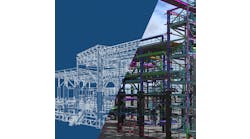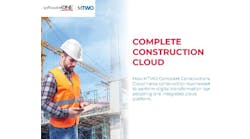Infrastructure
Planning Challenges
The enormous growth in population and industry experienced by the city has placed major challenges on its infrastructure planning operations. The fact that the city has more than doubled in size over the last two decades calls for careful infrastructure planning to make sure that planned works are adequately sized and delivered just in time. Engineers need to closely monitor the city's growth because if any area exceeds the capacity of the local sewers, sewage can back up onto private property or be discharged into the environment.
Previously, sewer modeling in the City of Surrey was performed by Amin Lalani, Sewer and Water planning manager, using an in-house computer model. The problem with this model was that the considerable number of simplifying assumptions that had to be made left the accuracy of the model in doubt. Another drawback was that it took about six month's time for Lalani and an assistant to update the model to accommodate one year's growth. Finally, without any graphical output the previous model could not be easily understood by the non-technical people such as city officials and developers who often were involved in the planning process.
Need For a Graphical Model
Lalani and Mike Darbyshire, Sewer & Water Systems manager for the City, came to the conclusion that they needed to develop a graphical hydraulic model. The city had recently invested in ArcInfo GIS software from ESRI, Redlands, Calif., and had created a model that completely depicted the City from a geographical and lot planning standpoint. "We realized that it would be an enormous task to develop a sewer model from scratch for a city of our size," Lalani said. "We were hoping that it might be possible to leverage the investment we had already made in our GIS system in order to reduce the time and cost required to build a model."
Lalani and Darbyshire
interviewed a number of consultants with experience in developing large sewer models. They were impressed by the experience of Chris Johnston, Kerr Wood Leidal Associates Ltd., North Vancouver, B.C., and their project team that included CH2M Gore and Storrie Ltd. and Crawford Engineering Associates. Johnston showed them how a software package (HYDRA for Pizer, Inc., Seattle, Wash.) could reduce the time required to create the model.
According to Johnston, this software package provides powerful tools not only for importing the GIS model but also for correcting the large number of errors that are present in almost every GIS model. It automatically checks the continuity of the imported data, and provides a series of reports that highlight nearly every problem.
Extracting Data from GIS Model
The ability of Kerr Wood Leidal's project team to make use of the existing GIS model was a key factor in helping the company win the project through the proposal evaluation process. The project began by exporting two primary layers from the City's GIS: the sanitary sewer layer and the parcel layer. The sanitary sewer layer includes the spatial network and physical attributes such as length, diameter, upstream/downstream coordinates, elevation and material. The parcel layer includes the surface area, zoning and owner of every lot in the city. The dBASE files associated with GIS information were imported into Microsoft Access to produce a file that includes spatial coordinates and links to the attributes contained in the parcel layer. Since that time, a GIS Layer Wizard has been introduced that automates this process using ESRI Shape files. The user can now simply specify the files that contain the GIS layers and the wizard automatically brings them into the program.
The next step was error checking. Johnston took advantage of the error-checking routines contained in the sewer modeling program. Reports produced by the program highlighted continuity problems, missing data and other errors. These errors had not been detected up to this point because the GIS had been used primarily only as a graphical tool. After making the corrections, a table was produced that showed all of the errors, which was passed back to the City for use in correcting the GIS database.
Loading the Sewer Model
The next step was loading the sewer model. For the residential lots, Johnston used 1996 census data to calculate the number of persons per lot for each sector of the city. He then used that figure to load each individual lot in each sector. The process of loading industrial, commercial and institutional lots was more challenging. Johnston used figures from other cities to determine a standard figure for loading each type of lot based on an equivalent number of persons per hectare. Johnston then added an allowance for each lot to depict inflow and infiltration based on the results of a detailed analysis undertaken by the regional district.
Johnston then created two additional model scenarios. One assumed that all of the additional development specified in the city's current zoning plan would be completed. The next scenario included additional development specified in the community plan. In the meantime, Kerr Wood Leidal contracted Southwestern Flowtech and Environmental, Surrey, to install 28 new sewer flow monitoring stations to complement the 26 stations for which data already had been collected. These stations measured flow at strategic points in the city's sewer system to validate the accuracy of the sewer.
Modeling Growth Scenarios
Johnston then was ready to run the analysis to determine the ability of the existing infrastructure to handle the current load as well as the two growth scenarios. The first time Johnston ran the analysis, its predictions closely matched the information collected by the monitoring stations in the residential areas. However, the model's predictions exceeded physical measurements in the industrial areas. The model overlays color codes on top of a graphical depiction of the system in order to make it easy to spot deficiencies. This initial iteration clearly showed that Johnston's estimate for sewer loading in industrial areas was too high. The reason for this overestimate was most likely the fact that Surrey's industry is heavily weighted toward distribution businesses that are not burdensome on the sewer system. It was a relatively simple process to reduce loading factors in industrial areas until the model's predictions matched measurements recorded by the monitoring stations.
After making this correction, the model accurately predicted flows and depths throughout the entire system. Johnston turned the model over to Darbyshire and Lalani who began using it as an integral part of the planning process.
"The model provides an excellent decision-making tool," Darbyshire said. "You can simply click on a pipe to see in a single window everything you need to know for your plan. It shows the physical parameters, areas tributary to that node population tributary to that node, and the current hydraulic grade line. In other models you have to manually calculate area and population tributary to a node. I especially like the color-coding in which serious deficiencies are highlighted in red and lesser deficiencies are in yellow."
The final total was that 23,000 pipes and 87,000 lots were modeled.
Huge Return on Investment
According to Darbyshire, in the year since the model has been running it already has proved its worth.
"The most dramatic example came when we analyzed one area where we had previously planned to put in a new sewer," Darbyshire said. "The model showed that the new sewer would not be needed for another five years. Additional savings have come through our ability to prove that new developments will overtax the existing infrastructure. In one recent case we showed that a particular development would pose a problem. As a result, the developer had to pick up the $50,000 cost of downstream improvements."
All in all, the new model has been well received. "When you're facing a question of whether or not to invest millions of dollars of taxpayers' money for new sewers, you can't rely on guesswork," Darbyshire said. "We can now produce precise sewer loading calculations for any growth scenario that we want to investigate."


